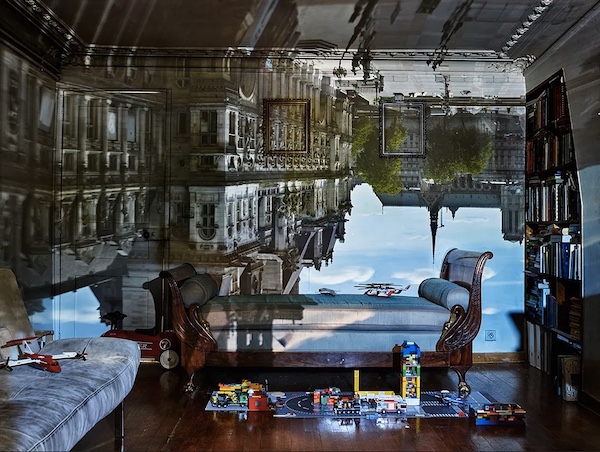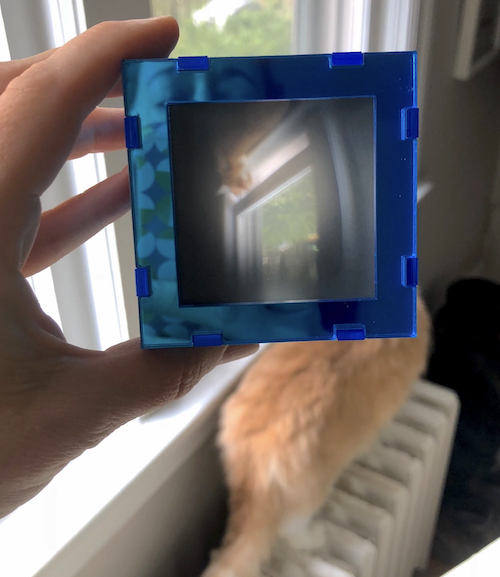Our Research Notes series invites authors to describe their process for a recent book, with “research” defined as broadly as they like. This week, Anna Cox writes about I Keep My Worries in My Teeth from Little A.
+
 My novel, I Keep My Worries in My Teeth begins and ends inside a camera obscura. A camera obscura is a simple thing that produces big wows. Needing nothing but light streaming through a pinhole and into a darkened room, a camera obscura transforms the ordinary into the extraordinary. A precursor to modern photography, this optical peepshow shifted and continues to shift how we see and understand the world.
My novel, I Keep My Worries in My Teeth begins and ends inside a camera obscura. A camera obscura is a simple thing that produces big wows. Needing nothing but light streaming through a pinhole and into a darkened room, a camera obscura transforms the ordinary into the extraordinary. A precursor to modern photography, this optical peepshow shifted and continues to shift how we see and understand the world.
As early as the 4th century BCE, Mozi, a Han Chinese philosopher and founder of the Mohist School of Logic, described the phenomenon of a ray of light entering a dark room through a small hole that would project the outside world, inside and upside down. He described this as a “treasure house” and while that translation was later proven inaccurate, it’s an apt description for the hypnotic experience of standing inside a darkened room, waiting for the outside world to stream in and meet you.

Abelardo Morell, Camera Obscura: View of Central Park Looking North, Fall 2008.

Abelardo Morell, Camera Obscura: View of Hotel de Ville, Paris, France, 2015.

Abelardo Morell, Camera Obscura: View of Central Park Looking West in Bedroom, Summer 2018.
+
I’m a writer but I’m also a photography instructor and most semesters I teach an introductory photography class. At the beginning of the course, students are either terrified or exhilarated by the technical mumbo jumbo that gets mistaken for photography. Photography isn’t about gadgets and big lenses, it’s about slowing down and learning to see. That’s why, on day one, we turn the classroom into a camera obscura because nothing upends technical nonsense quicker than the no-tech magic of blocking out windows, poking a hole, and watching the upside down world spill in. It’s transformative.

Abelardo Morell, Camera Obscura: View of Landscape Where Galileo Died in Exile, 2009.
+
At its best, photography is liberatory, spotlighting the shadowed and highlighting the ignored. The world has always benefitted from that perceptual acumen, but we especially need it now.
So, let us turn our bedrooms, bathrooms, kitchens, and cars into cameras obscura and start righting the world by looking at it upside down. It’s easy and fun and you probably already have what you need.
What you need for low-tech wonder:
- A room with a window and a wall opposite that window. If you don’t have a wall you can use a big light-colored sheet or a piece of white cardboard.
- Opaque black plastic or cardboard to cover the window. Thick lawn and leaf garbage bags are best, but several layers of cheaper bags work just fine.
- Scissors or an X-Acto knife or a utility knife
- Duct tape or electrical tape
+

During quarantine, University of Guelph undergraduate, Emma Ongman turned her bedroom into a camera obscura.
+
Two videos with simple instructions on how to build your own camera obscura:
This one from the George Eastman Museum shows how to turn a bedroom into a camera obscura and includes tips on how to use a sheet if you don’t have an empty wall to project the image on to.
+
This video is a team from National Geographic attempting to make a camera obscura similar to the one Abelardo Morell used to create the images at the beginning of this essay. The video includes a bit of narration from Abelardo Morell explaining what a camera obscura is.
+
Cameras obscura aren’t just historical precursors, contemporary artists utilize them. Abelardo Morell is perhaps the most well known artist working with a camera obscura. Morell’s recent work used a portable tent camera obscura.
Trudy Lynn Smith is a Canadian artist and anthropologist who also creates images with a portable camera obscura. They might make you rethink poking a small hole in your tent.

Trudi Lynn Smith, Prince of Wales Hotel Hill, Waterton Lakes National Park, 2009.
+
The cameras obscura in I Keep My Worries in My Teeth are pivotal spaces in the narrative. One character witnesses a devastating fire that impacts the entire town and another character loses her virginity inside a camera obscura facing the Great Lake. (I’m a bit jealous of that one, if I could go back in time…) At the end of the novel, it’s the joy of the camera obscura that helps to heal a grief-stricken town.
The retirement home busses elderly residents to the camera obscura by the lake. They divide into two groups. The outside group thrust their wrinkled palms to the sun, while inside the camera obscura, the other group cheers as their outside friends seem to defy gravity and age by walking on their hands. The groups switch places, and when it’s time to leave, the residents board the bus with the vitality of the very young. Teen girls gather inside to talk about their dreams, but they’re disrupted by clods of teen boys who stand in the hot sun and hurl buckets of water into the air. Even though the girls are safe inside, they squeal as water plummets toward their supine bodies.
During the last stages of editing, I had a research fellowship and enrolled in class on pre-photographic technology at the George Eastman Museum. In class we made a palm-sized box camera obscura out of cardboard and hand-ground glass. After cutting and gluing, the small group of photo professionals wandered around the museum’s garden, holding small boxes, looking at the upside down landscape as if we’d never visually processed anything. It’s hard to explain the weird wonder of watching through a tiny camera obscura. When I returned home, I put the cardboard box on my windowsill and during the first snowfall I didn’t look out the window, I looked through the back of that tiny box and watched the snow rise. When people came into my apartment, it was the first thing they noticed. It seems odd, but it feels like witnessing your life as a movie, even if that movie is just your side yard which is suddenly compelling.
Bookstores don’t generally give first-time novelists much sway and blocking their windows with black plastic to transform a store into a camera obscura for a reading was a big ask, so instead I created a portable camera obscura. Using the cardboard version as a model, I collaborated with a sculptor and designed a brightly-colored and shinier one. The lens is mounted on a box that slides in and out for focusing. I hand-assembled 50 laser cut, mirrored acrylic, cameras obscura to accompany the advanced reader copies of my novel. If you’re considering writing a novel that has some photographic elements in it and you think grinding glass for the back of 50 cameras obscura is a good idea, I can assure you that it’s not.


Images by Peter Denton

Steve, the inverted feline. The pattern on the back is a reflection of my phone case.
+
We will eventually be turned out into the world again. So, after you’ve turned your room into a camera obscura, here is a list of cameras obscura to visit around the world, and here is another.
Maybe you’ll visit the Cloud Chamber in Raleigh, North Carolina

Jeff Myers on Flickr
+
Or, the iconic Giant Camera obscura at Cliff House in San Francisco.

Image by Jill Reid/ CC by SA-20
+
If you’re near Nashville, Tennessee I suggest this one maintained by Vanderbilt University.

+
If you make a camera obscura, I’d love to see what you see. Please send me a picture.
Instagram: @mrsjonathanhart or IKeepMyWorriesInMyTeeth at Gmail.
+++